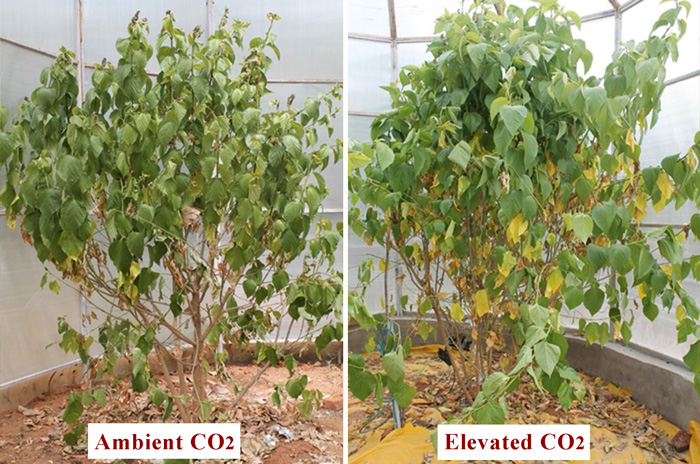| Follow @co2science |
Paper Reviewed
Sekhar, K.M., Reddy, K.S. and Reddy, A.R. 2017. Amelioration of drought-induced negative responses by elevated CO2 in field grown short rotation coppice mulberry (Morus spp.), a potential bio-energy tree crop. Photosynthesis Research 132: 151-164.
Mulberry (Morus spp.) is a fast growing semi-deciduous tree cultivated around the world. It has particular importance to the sericulture industry in the rearing of silkworms and the production of silk, but it is also gaining prominence in animal husbandry as a forage crop due to a high level of antioxidants and proteins in its leaves.
In light of such agronomic importance, the three-member research team of Sekhar et al. (2017) set out to investigate how this woody tree crop might respond to future changes in climate and atmospheric CO2. To that end, they investigated the interactive effects of elevated CO2 and water stress on a drought-tolerant cultivar (selection-13).
The experiment was conducted in open top chambers at the botanical garden of the University of Hyderabad, India, where six-month-old saplings were planted into chambers of either ambient (400 ppm) or enriched (550 ppm) atmospheric CO2. Thereafter, the scientists cut the plants every four months at stump height (30 cm above the soil surface) to create a coppice culture system. After one year, a subset of plants was subjected to drought stress, where all water was withheld for 30 days, during which time Sekhar et al. measured a number of physiological and morphological parameters on the trees.
In describing their findings, the three scientists say they observed evidence of visual stress in the drought treatments under both elevated and ambient CO2 conditions, but that such stress was less under elevated CO2 (see Figure 1 for a visual representation of the stress difference among ambient and elevated CO2 treatments). In quantifying this visual stress using ImageJ software, Sekhar et al. report that "plants grown under elevated CO2 had more green leaves (58%) and individual leaf densities (60%) with less leaf senescence (78%) compared to their ambient controls." In addition, they note there was "a significant decrease in total chlorophyll content (45%) in ambient CO2 grown plants" compared to high CO2 grown plants. What is more, plants grown in the CO2-enriched environment had greater net photosynthesis, water use efficiency and aboveground fresh (92%) and dry (83%) biomass, as well as reduced stomatal conductance and transpiration.

Figure 1. Morphological changes in mulberry plants grown under ambient and elevated atmospheric CO2 shown after 30 days of induced water stress. Source: Sekhar et al. (2017).
Another important observation was found in measurements of plant oxidative stress. Here, Sekhar et al. report that mulberry trees growing in the CO2-enriched environment produced less reactive oxygen species and triggered more and better antioxidant systems to combat the drought-induced oxidative stress.
Altogether, their combined findings, in the words of Sekhar et al. "clearly demonstrate that future increases atmospheric CO2 enhance the photosynthetic potential and also mitigate the drought-induced oxidative stress" in mulberry. And that is wonderful news for those who rely on this tree species for their livelihood!
Posted 16 August 2017



